How to make a screen for a bathtub from a tile: methods of self-arrangement
The decorative panel under the bathroom gives the bathroom a finished look. For its design, you can choose a plastic or acrylic design. However, they will cost a lot, especially if the bowl has a non-standard shape.
It will be cheaper to build this screen yourself from tiles, which are glued to a specially prepared frame. In addition to financial benefits, this decor option will fit perfectly into the interior of the room - they try to choose ceramic finishes in accordance with the walls and floor.
We will figure out how to make a screen for a bathtub - we will describe how to equip the base for tiles and the technology of facing work. We supplemented the information with visual photo instructions and video clips that will help you independently perform all the finishing processes.
The content of the article:
Why make a screen under the bathroom?
The walls and floor in the bathroom are tiled, and the plumbing is installed in its place and connected to communications. Everything looks great. The only problem that spoils the view is the space under the bathroom from its side down.
To make the interior of the room look harmonious and complete, you must somehow close the bathhouse itself and the pipes connected to it.
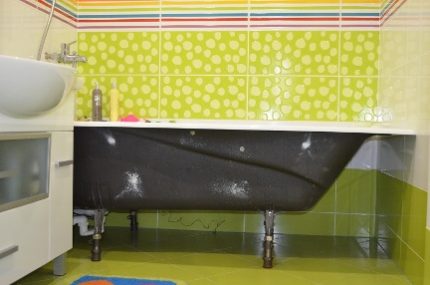
If plumbing for bathing is made of acrylic or plastic, then in most cases it looks quite decent from the outside. And cast iron or steel products, on the contrary, are not pleasing to the eye. They must be decorated outside, otherwise the bathroom will not look too neat.
Often, housewives under the bathtub store detergents and other household goods. All this, as well as communications, it is desirable to close decorative screen.
Such a screen is a great way to hide the superfluous and not too beautiful in appearance.All these jars, phials, rags and pipelines will be behind it reliably hidden from the eyes of people.
If the bathroom is tiled, then the screen under the bath is recommended to be made also from it. So the design of this room can be issued in a single completed style.
The main thing when installing this decor is not to forget about the need to have access to communications. The screen will need to make a hatch through which in case of leaks it will be possible to get to the pipes for their repair.
Possible design options
Bathtubs vary in form, material of manufacture and functionality. But the methods of designing the space under them using tiles are the same in all cases. It is necessary to make a reliable foundation for the tile, and then stick it in accordance with all the rules and wipe the seams.
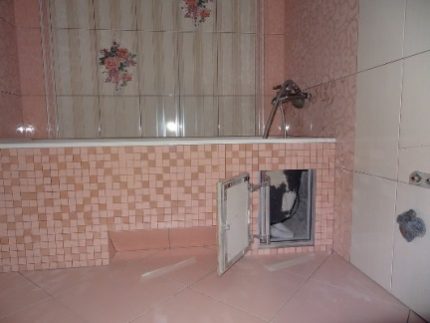
Structurally, screens under the bathroom can be:
- with swing or sliding doors;
- removable or capital;
- with drawers shelf designs or without them;
- deaf and with a niche below the legs.
The easiest way to lay tiles - under the side of the bath. When using it, you don’t have to spend energy on carefully aligning the new edge.
It is enough to lay the top row of tiles under the side of the bathhouse or flush with it vertically. An additional plus is the frame and the rough surface for the ceramic sticker in this case, it will also be easier to do.
If it was decided to use ceramic tiles for facing a niche under the bathroom, then the easiest way is to make a blank solid screen out of it without any frills. However, with blockages and leaks, it will not allow you to get to the communications. It will be necessary to break it, and then re-decorate everything. It is difficult to call such a decision thoughtful.
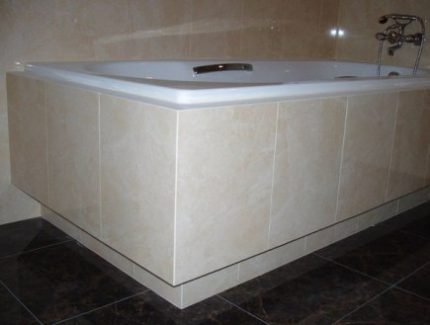
More practical option with revision door or window. With the device of such a screen, a technological hole is provided, closed with a plastic hatch or a removable panel the size of one tile. It turns out both presentable and practical.
It is extremely difficult to make screens with sliding or swinging sashes out of tiles. The tile should be glued to a solid and skew-free base. And in the case of opening and closing door leafs, this is impossible to achieve. Tiles will inevitably fall off such a surface.
The bath is often used for bathing babies and washing clothes. At the same time, standing next to her is close. If the niche is not made on the floor or the screen does not have a downward slant inward from the edge of the bowl, then there will be nowhere to put your feet in this situation.
Standing nearby, you have to bend deeper, unnecessarily straining your back. When decorating the bath, it is imperative to provide a recess for the feet.
The choice of ceramics for the panel for the bath
Glazed ceramic tiles are moisture resistant and durable. It is easy to maintain and install. Its only drawback is the fragility of the glazed layer; upon impact, it easily crackes. But if you do not throw heavy objects into the tile, then this problem is not so urgent and significant.
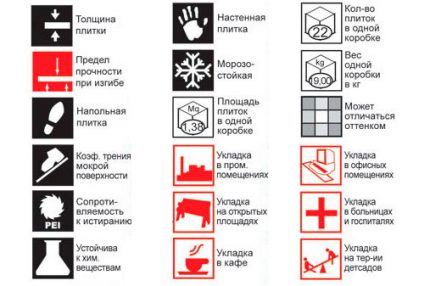
The dimensions of most bathtubs are modest. Tiles for decorating the space below them are recommended to choose a small or medium size. Large plates will have to be cut, and these are excess residues and potential losses from cracking of the glaze during inaccurate cutting.
You can also use mosaics to clad the screen. However, laying out a pattern of small elements is long and laborious.It is easier to choose ready-made mosaic modules in the form of sheets from a fiberglass mesh with ceramics already glued to it. They will just need to be cut and fixed on a partition made of drywall or brick.
Forming a base for a tile
Tile under the bathroom can be glued to a wall made of drywall, brick or tongue-and-groove plates. All three options are acceptable.
But the brickwork will weigh quite a lot, so it should be used only as a last resort. It is better to avoid excessive load on the bathroom floor from a brick partition with a length of one and a half and a height of about half a meter.
Method # 1: Plasterboard sheets on a frame
A rough base for tiles quickly and easily can be done with drywall. To do this, you need to build a frame of bars or a metal profile of the desired configuration, and then sheathe it with plasterboard plates. Moreover, if wood is selected for the assembly of the frame, then it must be impregnated with antiseptics.
The main thing - drywall for installation in the bathroom should be taken exclusively moisture resistant brands (GKLV) with a green shade surface. This material does not rot and mold does not form on it. It is strong, durable and will not swell from water that has fallen on it.
It is categorically not recommended to use ordinary GCR or wood-pressed boards without lamination in a bathroom with its constant humidity.
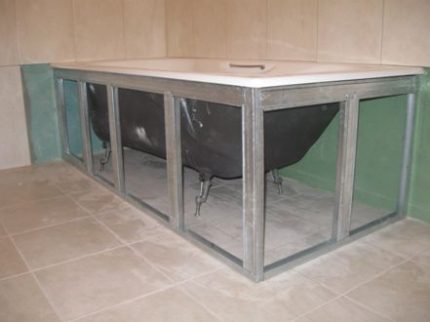
The basis for tiling is done as follows:
- Markup. Mark the lines around the perimeter of the bath on the walls and floor flush with its side.
- Frame mounting. A frame is assembled from metal profiles. The frame is installed on all sides of the bath, designed for decoration. The structure is leveled and fixed with dowels to the floor and walls.
- Drywall Cutting. The sheets are cut taking into account the gaps in a centimeter near the floor and the side of the bath, which will then be filled with sealant.
- GKL mount. Drywall sheets are attached to the frame with self-tapping screws in increments of 10-15 cm.
- Hatch preparation. At the inspection site, a hole for the hatch is made of plastic.
- Seam processing. The joints between the GKL canvases and the walls are glued with a serpentine. Seams around the perimeter of the drywall construction are coated with sealant, and the surface of the sheets is covered with an acrylic primer.
It is not necessary to tighten the screws when fixing the GCR, this can lead to destruction of the sheet in the place of their screwing. And fasteners must be chosen short so as not to accidentally damage the sides of the bath.
The inspection hatch will be installed after the sticker of the tile at the final design of the screen under the bath. For its fixation, ordinary liquid nails are enough.
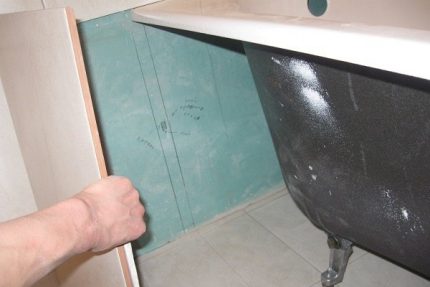
When mounting the frame, you can use mounting foam. It will stick to the outer side of the bathtub, drywall and profile or bars, thereby combining them into a single structure. It is only necessary to make sure that it does not squeeze out the individual elements of the partition formed under the bath, otherwise the screen will turn out to be curved.
And here is a variant of the frame with subsequent cladding without mounting on dowels. Instead, a plumbing sealant was used to fix the profile. The following materials will be required for work:
Having prepared all the materials and tools in advance, you can start work. First we do the marking, then we establish the basis for the frame, the frame itself and lay the tiles.
Do not forget about the hole for the technical hatch - it will come in handy when you need to eliminate the blockage or change the drain details.
Often bath support frame, erected during the installation of plumbing, serves as the basis for fastening sheets of drywall.
Method # 2: Bricklaying
A beautiful and durable tiled screen can be made in the form of a small brickwork. To do this, in addition to bricks, you will need a solution at the rate of 1 part of M-200 cement for 6 parts of sand and working skills as a bricklayer.
Such a partition is intended solely for gluing tiles; it is unacceptable to use it as a supporting stand for a bathtub. To do this, there are special legs and mounting frames. Moreover, between the upper bricks and the bowl of the bath should remain a gap of 2-3 cm to fill the mounting foam.
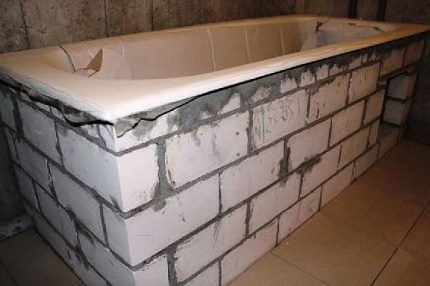
Laying the first row, it will be necessary to remove two or three bricks in the middle of the bath to form a niche for the legs in the place that follows. And also do not forget about the opening for installing the inspection hatch.
After the masonry is completed and the mortar hardens, the resulting partition will still need to be smoothed with plaster so that it can already be glued onto it.
It will be possible to start facing with ceramics only after two to three days. This time should be enough so that the solution finally sets and dries, and the septum passes the stage of shrinkage deformation. If the tile starts to be glued immediately, then after a couple of days it can simply fall off due to an imperceptible masonry displacement.
Photo-installation instructions for the screen for an acrylic corner bath. The mosaic was chosen as the facing material - it best fits on curved surfaces.
Brick creates a foundation that does not deform over time and requires little repair.
Method # 3: Partition from tongue-and-groove plates
Instead of brick, the base for tiles can also be made of tongue-and-groove plates. It can be gypsum moisture resistant or silicate products. Both options can be used in bathrooms.
They are produced according to the standard with a minimum width of 80 mm, which makes it easy to create a solid supporting structure for tiles under the rim of almost any bathtub.
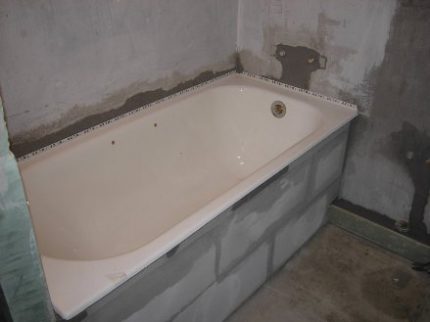
The plates are joined together using special glue or gypsum plaster. The presence of grooves and ridges along the edge of the product greatly simplifies masonry.
To bind the partition to the wall of the bathroom, metal brackets and dowels are used. The result should be a flat surface, completely ready for gluing ceramic tiles.
Tile bonding nuances
The finishing lining of the partition formed under the bathroom is done using tile glue or liquid nails. The first option is applied to the back of the tile with a notched trowel, and the second - from the tube with several points along the perimeter and in its center.
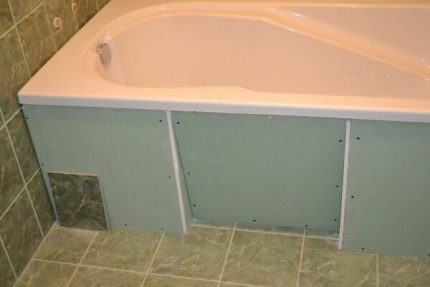
So that the tiles do not float to the sides, plastic crosses are inserted between them, allowing you to precisely control the size of the tile joints. The latter, after finishing the lining, must be grouted. Otherwise, water will pass through them under the ceramics, which sooner or later will lead to its decay.
Removable screen construction
In addition to rigidly fixed structures, to decorate the space under the bathroom, make a removable panel.
To create a mobile screen you will need:
- OSB;
- tile;
- furniture legs adjustable in height;
- slats 20x40 mm to create a frame for supports.
First, a piece with such dimensions is cut off from the OSB sheet to completely close the side of the bath. Only in height do they make it slightly smaller, by five centimeters. The feet of the foot should freely enter into this gap from below. After cutting, the frame is filled on the OSB, and legs are already attached to it.
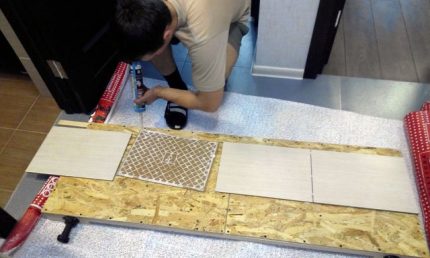
The tile on the wood base is glued according to standard technology using sealants and grout mixtures. After grouting the resulting screen, you can put it on the bathtub and adjust the legs so that it stands in its place evenly.
By twisting the supports, its upper edge must be pressed down to the side of the bathhouse, then this decorative panel will stand still.
Facing bathtubs of complex shape
If the swimming pool has curved contours, then a regular screen with tiles on it cannot be installed. The basis of drywall can be made of any shape. But then gluing large ceramic tiles to it is unlikely to succeed. Ceramics do not bend, it can only be broken.
However, a screen of complex configuration with arcuate outlines is quite possible to veneer using mosaics. Her small pieces are perfect for this purpose. She is not afraid of moisture and will serve in the bathroom for more than one year.
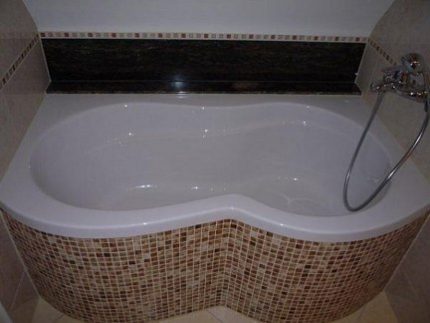
For cladding a bathtub or a jacuzzi, mosaic in the form of separate pieces, as well as ready-made modules on a flexible grid, are suitable. The first method is laborious and long. It is much easier to use modules with mosaic elements already pasted under a given pattern. With their help, it will be easy to repeat the contour of the bowl.
In addition to tiling, there are various options for decorating the space under the bathroom. One of the original ways - mirror screen. Alternative methods for creating a screen and technologies for their implementation are described in this article.
Conclusions and useful video on the topic
How to make a bathtub holder for an acrylic bath:
Installation of a decorative screen with tiles for a swimming pool:
The nuances of creating a frame for gypsum board based cladding:
If the appearance of the bath is not pleasing to the eye, then it can always be covered with a decorative screen. In a situation where the entire bathroom is tiled, it is also recommended to use it for decorating the bowl of the bath.
The basis for the tile is the easiest to make drywall, but options are possible from brick or tongue-and-groove plates. The device of such a decor is not something complicated, you can do it yourself.
Share with your readers your experience and interesting ideas for creating a screen under the bathroom. Please leave comments on the article and ask your questions. The feedback form is located below.

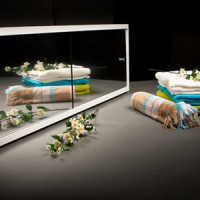 How to make a mirror screen for a bath: step by step instructions
How to make a mirror screen for a bath: step by step instructions 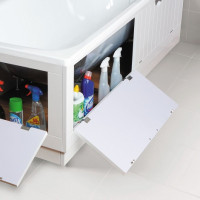 How to make a screen under the bath yourself: analysis of the nuances of installation
How to make a screen under the bath yourself: analysis of the nuances of installation 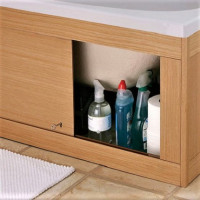 Sliding screen for the bath: step-by-step instructions for assembling the factory design + tips for craftsmen
Sliding screen for the bath: step-by-step instructions for assembling the factory design + tips for craftsmen 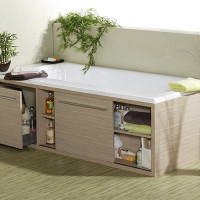 How to make a functional screen under the bathroom with shelves
How to make a functional screen under the bathroom with shelves 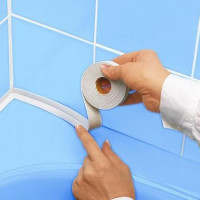 How to glue the curb onto the bath: analysis of laying rules + installation instructions
How to glue the curb onto the bath: analysis of laying rules + installation instructions 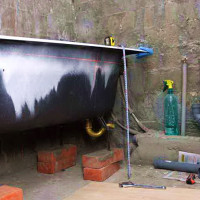 How to install a bath on bricks: step-by-step instruction on how to install
How to install a bath on bricks: step-by-step instruction on how to install  How much does it cost to connect gas to a private house: the price of organizing gas supply
How much does it cost to connect gas to a private house: the price of organizing gas supply  The best washing machines with dryer: model rating and customer tips
The best washing machines with dryer: model rating and customer tips  What is the color temperature of light and the nuances of choosing the temperature of the lamps to suit your needs
What is the color temperature of light and the nuances of choosing the temperature of the lamps to suit your needs  Replacement of a geyser in an apartment: replacement paperwork + basic norms and requirements
Replacement of a geyser in an apartment: replacement paperwork + basic norms and requirements
Personally, I am not a supporter of the fact that the basis of the screen for the bathtub is made of brick or slate sheet. It seems to me that the most optimal option is to use drywall or aerated concrete blocks. At least this way the design is lighter. It is also necessary to think over a hatch of a normal size, so that later it would be possible to carry out repairs and maintenance of communications.
In our bathroom there is a sliding screen made of plastic. Installed as soon as we moved. We live six years, no complaints. Doors move easily along grooves, although dust accumulates there, but it is not difficult to wash. Outwardly, I like how the sliding screen looks beautiful, modern and practical. Plus to everything: it came out quite inexpensively in cost.